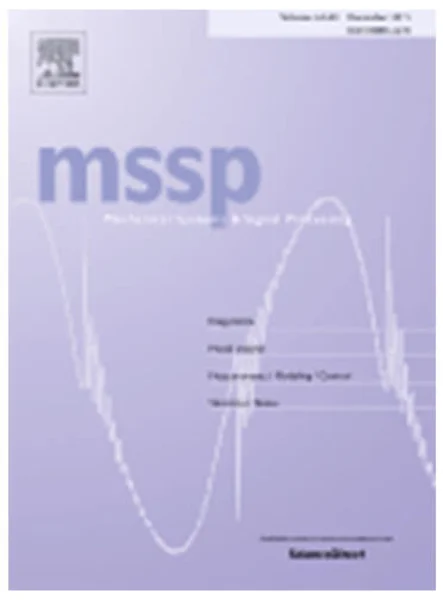-
time–frequency characterization of nonlinear normal modes and challenges in nonlinearity identification of dynamical systems
جزئیات بیشتر مقاله- تاریخ ارائه: 1390/01/01
- تاریخ انتشار در تی پی بین: 1390/01/01
- تعداد بازدید: 454
- تعداد پرسش و پاسخ ها: 0
- شماره تماس دبیرخانه رویداد: -
presented here is a new time–frequency signal processing methodology based on hilbert–huang transform (hht) and a new conjugate-pair decomposition (cpd) method for characterization of nonlinear normal modes and parametric identification of nonlinear multiple-degree-of-freedom dynamical systems. different from short-time fourier transform and wavelet transform, hht uses the apparent time scales revealed by the signal's local maxima and minima to sequentially sift components of different time scales. because hht does not use pre-determined basis functions and function orthogonality for component extraction, it provides more accurate time-varying amplitudes and frequencies of extracted components for accurate estimation of system characteristics and nonlinearities. cpd uses adaptive local harmonics and function orthogonality to extract and track time-localized nonlinearity-distorted harmonics without the end effect that destroys the accuracy of hht at the two data ends. for parametric identification, the method only needs to process one steady-state response (a free undamped modal vibration or a steady-state response to a harmonic excitation) and uses amplitude-dependent dynamic characteristics derived from perturbation analysis to determine the type and order of nonlinearity and system parameters. a nonlinear two-degree-of-freedom system is used to illustrate the concepts and characterization of nonlinear normal modes, vibration localization, and nonlinear modal coupling. numerical simulations show that the proposed method can provide accurate time–frequency characterization of nonlinear normal modes and parametric identification of nonlinear dynamical systems. moreover, results show that nonlinear modal coupling makes it impossible to decompose a general nonlinear response of a highly nonlinear system into nonlinear normal modes even if nonlinear normal modes exist in the system.
مقالات جدیدترین رویدادها
-
استفاده از تحلیل اهمیت-عملکرد در ارائه الگوی مدیریت خلاقیت سازمانی و ارائه راهکار جهت بهبود
-
بررسی تاثیر ارزش وجوه نقد مازاد بر ساختار سرمایه شرکت های پذیرفته شده در بورس اوراق بهادار تهران
-
بررسی تأثیر سطح افشای ریسک بر قرارداد بدهی شرکت های پذیرفته شده در بورس اوراق بهادار تهران
-
بررسی تأثیر رتبه بندی اعتباری مبتنی بر مدل امتیاز بازار نوظهور بر نقد شوندگی سهام با تأکید بر خصوصی سازی شرکت ها
-
تأثیر آمیخته بازاریابی پوشاک ایرانی بر تصویر ذهنی مشتری پوشاک ایرانی (هاکوپیان)
-
بررسی نقش و اهمیت ارتباط بین علوم روانشناسی در توسعه پایدار علوم انسانی
-
بررسی ارتباط محافظه کاری حسابداری با هزینه سرمایه در شرکت های پذیرفته شده بورس اوراق بهادار تهران
-
تأثیر عوامل آمیختۀ بازاریابی خدمات (7p) بر ترجیح مشتریان در انتخاب بانک ملی (مورد مطالعه : شعب شهرستان بیرجند)
-
مقاومت برشی خاک های غیر اشباع در شیروانی های خاکی
-
triple-frequency carrier ambiguity resolution for beidou navigation satellite system
مقالات جدیدترین ژورنال ها
-
مدیریت و بررسی افسردگی دانش آموزان دختر مقطع متوسطه دوم در دروان کرونا در شهرستان دزفول
-
مدیریت و بررسی خرد سیاسی در اندیشه ی فردوسی در ادب ایران
-
واکاوی و مدیریت توصیفی قلمدان(جاکلیدی)ضریح در موزه آستان قدس رضوی
-
بررسی تاثیر خلاقیت، دانش و انگیزه کارکنان بر پیشنهادات نوآورانه کارکنان ( مورد مطالعه: هتل های 3 و 4 ستاره استان کرمان)
-
بررسی تاثیر کیفیت سیستم های اطلاعاتی بر تصمیم گیری موفق در شرکتهای تولیدی استان اصفهان (مورد مطالعه: مدیران شرکتهای تولیدی استان اصفهان)
-
طراحی الگوی درمان مبتنی بر پذیرش و تعهد بر اساس اسلام
-
تاثیر سرمایه فکری بر رابطه بین حاکمیت شرکتی و عملکرد شرکت های پذیرفته شده در بورس اوراق بهادار تهران
-
اثربخشی مداخله مبتنی بر تنظیم هیجان بر راهبردهای نظم دهی شناختی هیجانی و ناگویی هیجانی در بیماران مبتلا به نارسایی عروق کرونر قلب
-
مشارکت زنان در انتخابات از دیدگاه فقه اسلامی با تأکید بر فرهنگ ملی افغانستان
-
the study of substituent effect on osmabenzene complexes




سوال خود را در مورد این مقاله مطرح نمایید :